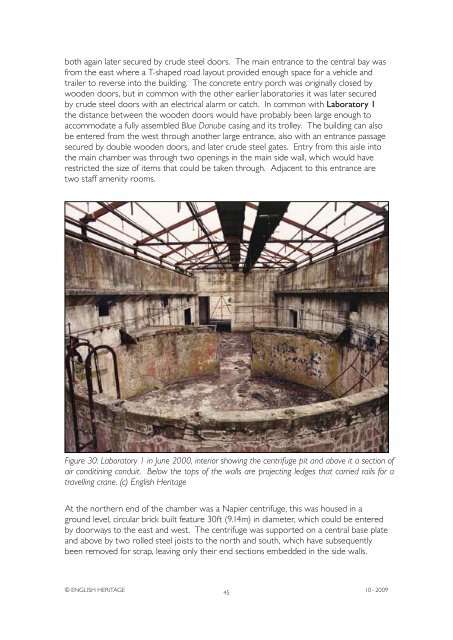Atomic Weapons Research Establishment. Orford ... - English Heritage
Atomic Weapons Research Establishment. Orford ... - English Heritage
Atomic Weapons Research Establishment. Orford ... - English Heritage
You also want an ePaper? Increase the reach of your titles
YUMPU automatically turns print PDFs into web optimized ePapers that Google loves.
oth again later secured by crude steel doors. The main entrance to the central bay was<br />
from the east where a T-shaped road layout provided enough space for a vehicle and<br />
trailer to reverse into the building. The concrete entry porch was originally closed by<br />
wooden doors, but in common with the other earlier laboratories it was later secured<br />
by crude steel doors with an electrical alarm or catch. In common with Laboratory 1<br />
the distance between the wooden doors would have probably been large enough to<br />
accommodate a fully assembled Blue Danube casing and its trolley. The building can also<br />
be entered from the west through another large entrance, also with an entrance passage<br />
secured by double wooden doors, and later crude steel gates. Entry from this aisle into<br />
the main chamber was through two openings in the main side wall, which would have<br />
restricted the size of items that could be taken through. Adjacent to this entrance are<br />
two staff amenity rooms.<br />
Figure 30: Laboratory 1 in June 2000, interior showing the centrifuge pit and above it a section of<br />
air conditining conduit. Below the tops of the walls are projecting ledges that carried rails for a<br />
travelling crane. (c) <strong>English</strong> <strong>Heritage</strong><br />
At the northern end of the chamber was a Napier centrifuge, this was housed in a<br />
ground level, circular brick built feature 30ft (9.14m) in diameter, which could be entered<br />
by doorways to the east and west. The centrifuge was supported on a central base plate<br />
and above by two rolled steel joists to the north and south, which have subsequently<br />
been removed for scrap, leaving only their end sections embedded in the side walls.<br />
© ENGLISH HERITAGE<br />
45<br />
10 - 2009

















